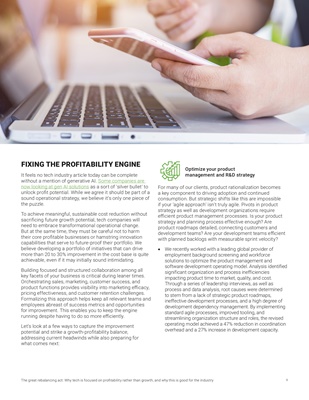
The great rebalancing act: Why tech is focused on profitability rather than growth, and why this is good for the industry 9
FIXING THE PROFITABILITY ENGINE
It feels no tech industry article today can be complete
without a mention of generative AI. Some companies are
now looking at gen AI solutions as a sort of 'silver bullet' to
unlock profit potential. While we agree it should be part of a
sound operational strategy, we believe it's only one piece of
the puzzle.
To achieve meaningful, sustainable cost reduction without
sacrificing future growth potential, tech companies will
need to embrace transformational operational change.
But at the same time, they must be careful not to harm
their core profitable businesses or hamstring innovation
capabilities that serve to future-proof their portfolio. We
believe developing a portfolio of initiatives that can drive
more than 20 to 30% improvement in the cost base is quite
achievable, even if it may initially sound intimidating.
Building focused and structured collaboration among all
key facets of your business is critical during leaner times.
Orchestrating sales, marketing, customer success, and
product functions provides visibility into marketing efficacy,
pricing effectiveness, and customer retention challenges.
Formalizing this approach helps keep all relevant teams and
employees abreast of success metrics and opportunities
for improvement. This enables you to keep the engine
running despite having to do so more efficiently.
Let's look at a few ways to capture the improvement
potential and strike a growth-profitability balance,
addressing current headwinds while also preparing for
what comes next:
Optimize your product
management and R&D strategy
For many of our clients, product rationalization becomes
a key component to driving adoption and continued
consumption. But strategic shifts like this are impossible
if your 'agile approach' isn't truly agile. Pivots in product
strategy as well as development organizations require
efficient product management processes. Is your product
strategy and planning process effective enough? Are
product roadmaps detailed, connecting customers and
development teams? Are your development teams efficient
with planned backlogs with measurable sprint velocity?
• We recently worked with a leading global provider of
employment background screening and workforce
solutions to optimize the product management and
software development operating model. Analysis identified
significant organization and process inefficiencies
impacting product time to market, quality, and cost.
Through a series of leadership interviews, as well as
process and data analysis, root causes were determined to
stem from lack of strategic product roadmaps, ineffective
development processes, and a high degree of development
dependency management. By implementing standard
agile processes, improved tooling, and streamlining
organization structure and roles, the revised operating
model achieved a 47% reduction in coordination overhead
and a 27% increase in development capacity.